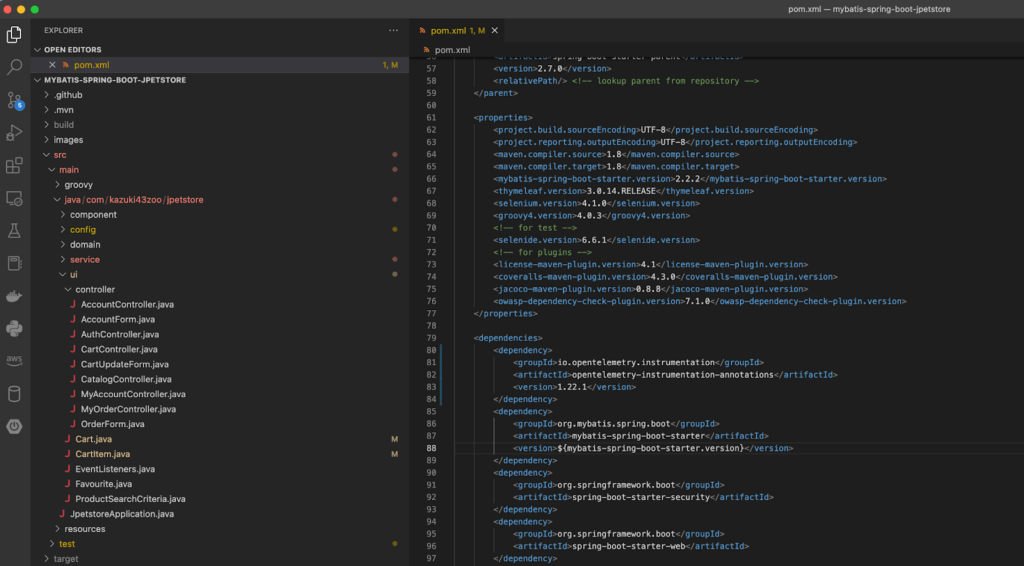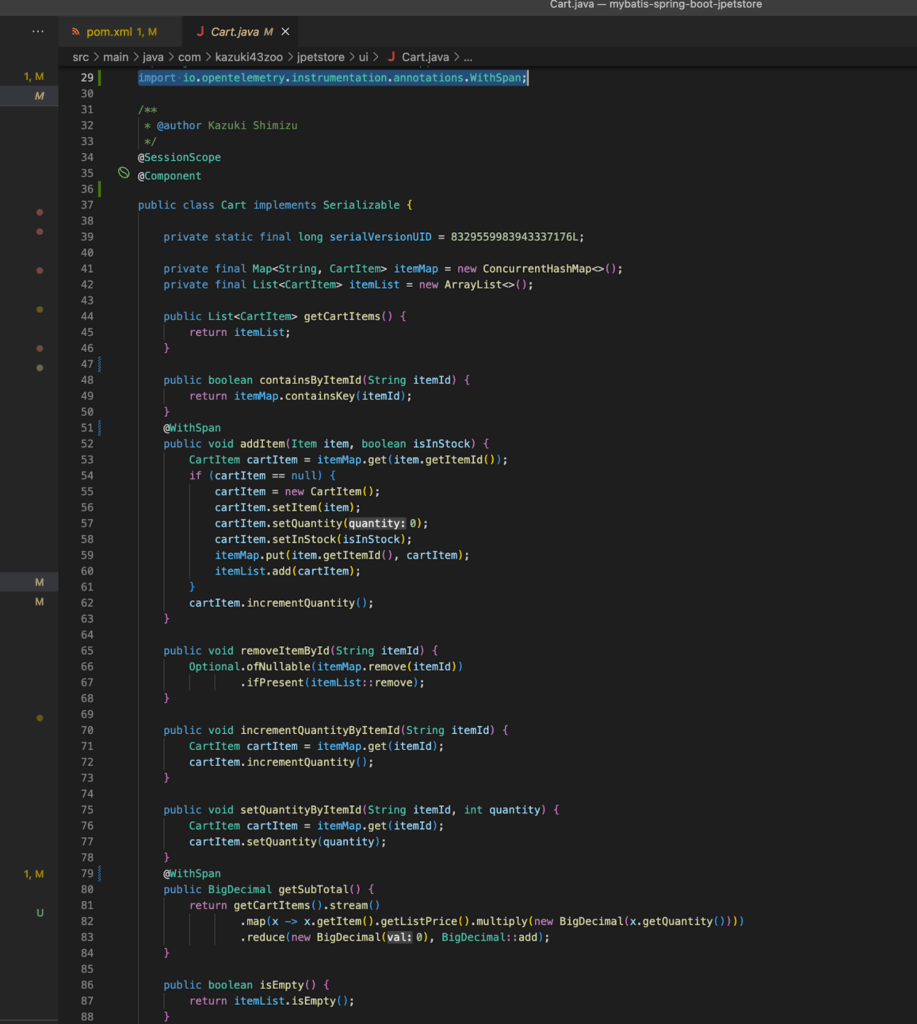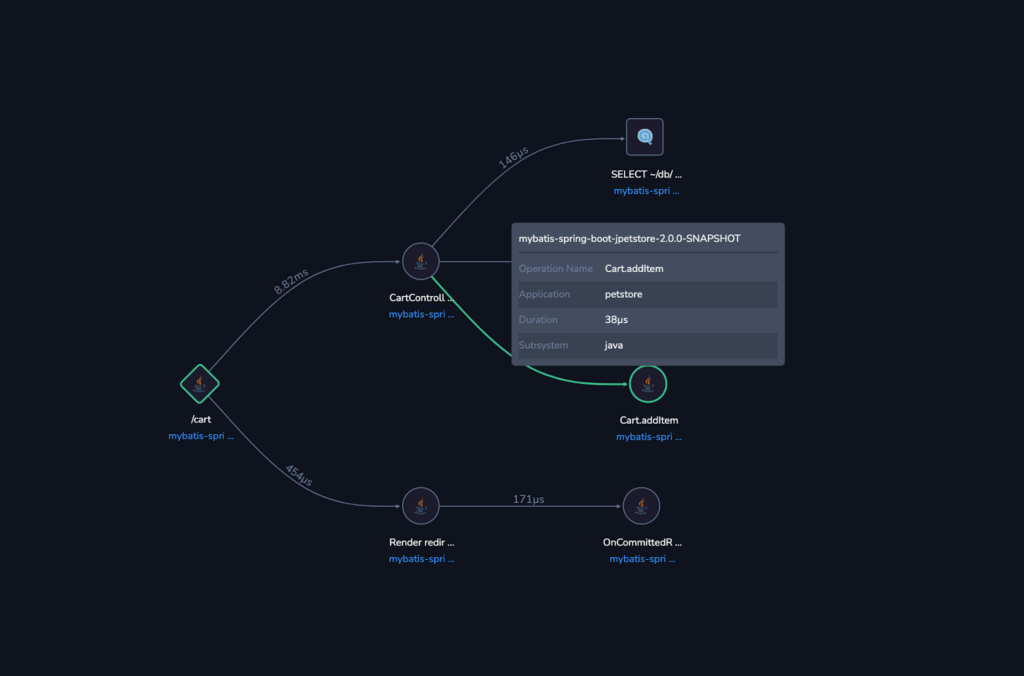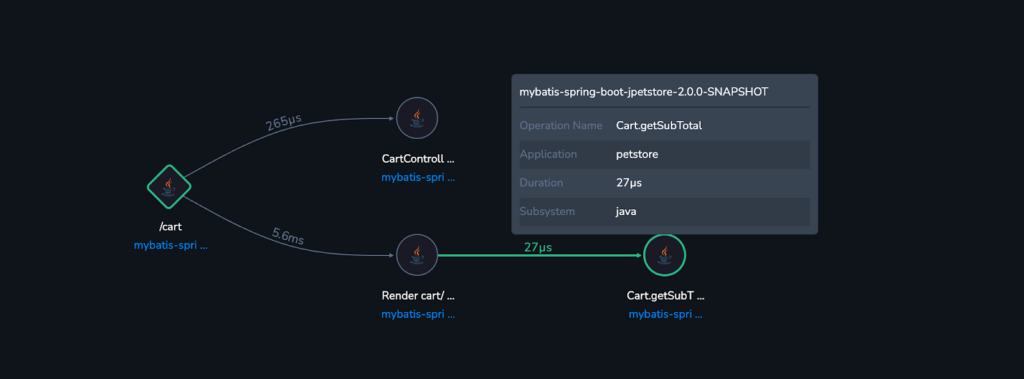Java OpenTelemetry Instrumentation
This tutorial demonstrates how to instrument your Java applications to capture OpenTelemetry traces and send them to Coralogix.
OpenTelemetry-Java automatic instrumentation is the most efficient method for adding instrumentation to Java applications. Requiring minimal modifications to the code, it uses a Java agent that can be attached to any Java 8+ application and dynamically injects bytecode to capture telemetry from several popular libraries and frameworks.
Note
While this tutorial demonstrates how to send data directly to Coralogix, we do not recommend doing so. Instead, we recommend using the OpenTelemetry Collector as a centralized place for sending your data to us.
Installation
The instructions below conform to the latest OpenTelemetry Java Auto Instrumentation, currently Java agent version 1.22.1.
STEP 1. Download and distribute the agent JAR.
Download the latest OpenTelemetry Java agent.
Apply the agent to each service host or container that requires access to it.
The JVM will require access to the agent to function properly.
STEP 2. Update the JVM configuration.
Either of the following options may be used as the template, with the following changes:
JAVA_TOOL_OPTIONS: Replace the path to the java agent JAR and thecoralogix-opentemetryJAR files with the file's location downloaded and distributed in STEP 1 above.OTEL_EXPORTER_OTLP_ENDPOINT: Select the OpenTelemetry endpoint associated with your Coralogix domain.OTEL_RESOURCE_ATTRIBUTES: Specify your Service.Name.OTEL_RESOURCE_ATTRIBUTES: Specify Your Coralogix Send-Your-Data API key, application, and subsystem name.Specify 4 RESOURCE_ATTRIBUTES for application and subsystem:
application.name: Replace with the name used for the identification of your Coralogix application nameapi.name: Replace with the name used for the identification of your Coralogix subsystem namecx.application.name: Replace with the name used for the identification of your Coralogix application namecx.subsystem.name: Replace with the name used for the identification of your Coralogix subsystem name
Option 1 (recommended): Leveraging environment variables
- Pass the Configuration parameters as system properties environment variables in the JVM:
export JAVA_TOOL_OPTIONS="-javaagent:path/to/opentelemetry-javaagent.jar —Dotel.javaagent.extensions=build/libs/opentelemetry-java-instrumentation-extension-demo-1.0-all.jar"
export OTEL_TRACES_EXPORTER="otlp"
export OTEL_METRICS_EXPORTER="none"
export OTEL_LOGS_EXPORTER="none"
export OTEL_EXPORTER_OTLP_TRACES_PROTOCOL="grpc"
export OTEL_EXPORTER_OTLP_ENDPOINT="<coralogix_otel_endpoint>"
export OTEL_EXPORTER_OTLP_TRACES_HEADERS="Authorization=Bearer <CXPrivateKey>"
export OTEL_RESOURCE_ATTRIBUTES=service.name=<ServiceName>,application.name=<CXApplicationName>,api.name=<CXSubsystemName>,cx.application.name=<CXApplicationName>,cx.subsystem.name=<CXSubsystemName>
java -javaagent:</path/to/>opentelemetry-javaagent.jar -jar myapp.jar
- View the full range of configuration options here.
Option 2: Changing the Java command line
- Enable the instrumentation agent using the
-javaagentflag to the JVM and pass the Configuration parameters as Java system properties (-Dflags):
java -javaagent:path/to/opentelemetry-javaagent.jar \
—Dotel.javaagent.extensions=build/libs/opentelemetry-java-instrumentation-extension-demo-1.0-all.jar" \
-Dotel.traces.exporter=otlp \
-Dotel.metrics.exporter=none \
-Dotel.logs.exporter=none \
-Dotel.exporter.otlp.traces.protocol=grpc \
-Dotel.exporter.otlp.traces.endpoint=<coralogix_otel_endpoint> \
-Dotel.exporter.otlp.traces.headers=Authorization=Bearer "<CXPrivateKey>" \
-Dotel.resource.attributes=service.name=<ServiceName>,application.name=<CXApplicationName>,api.name=<CXSubsystemName>,cx.application.name=<CXApplicationName>,cx.subsystem.name=<CXSubsystemName> \
-jar myapp.jar
Troubleshooting
Confirm that the instrumentation was installed by looking for the following log lines in your console:
[otel.javaagent 2023-02-14 10:40:00:811 +0000] [main] INFO io.opentelemetry.javaagent.tooling.VersionLogger - opentelemetry-javaagent - version: 1.21.1
Example
JPetStore 6 is a full web application built on top of MyBatis 3, Spring 5, and Stripes.
STEP 1. Install a version of the Java Development Kit. It will not deploy when using only the Java Runtime Environment.
STEP 2. Download the JDK for your platform.
STEP 3. Clone the jpetstore git repo:
STEP 4. Run the following:
STEP 5. Download the OpenTelemetry agent.
STEP 6. Apply the environment variables:
export OTEL_TRACES_EXPORTER="otlp"
export OTEL_EXPORTER_OTLP_TRACES_PROTOCOL="grpc"
export OTEL_EXPORTER_OTLP_ENDPOINT="<coralogix_otel_endpoint>"
export OTEL_EXPORTER_OTLP_TRACES_HEADERS="Authorization=Bearer <CXPrivateKey>"
export OTEL_RESOURCE_ATTRIBUTES=service.name=<ServiceName>,application.name=<CXApplicationName>,api.name=<CXSubsystemName>,cx.application.name=<CXApplicationName>,cx.subsystem.name=<CXSubsystemName>
STEP 7. Run the project with the agent:
java -javaagent:</path/to/>opentelemetry-javaagent.jar -jar mybatis-spring-boot-jpetstore-2.0.0-SNAPSHOT.jar
STEP 8. Navigate to http://localhost:8080/.
STEP 9. View the traces in your Coralogix dashboard.
Additional instrumentation using annotations
STEP 1. Open the project with your favorite IDE/text editor.
STEP 2. Edit the pom.xml file and add the following maven dependency:
<dependency>
<groupId>io.opentelemetry.instrumentation</groupId>
<artifactId>opentelemetry-instrumentation-annotations</artifactId>
<version>1.22.1</version>
</dependency>
STEP 3. Edit file src/main/java/com/kazuki43zoo/jpetstore/ui/Cart.java.
STEP 4. Add this import to the Java file where the methods you want to trace are present.
STEP 5. Before the function you wish to trace, add the annotation "WithSpan".
Example: cart.java
STEP 6. Rebuild your springboot application applying the changes (using either your IDE or command line).
STEP 7. Run your application again with the Otel agent:
java -javaagent:</path/to/>opentelemetry-javaagent.jar -jar mybatis-spring-boot-jpetstore-2.0.0-SNAPSHOT
Validation
In your Coralogix dashboard, navigate to Explore > Tracing to view the traces generated by your application.
Your traces should now contain additional spans on annotated methods.
Transactions
For customers with functional Java OpenTelemetry instrumentation, this section guides reconfiguring the existing setup to define, report, and monitor Coralogix transactions.
For new customers or those who haven’t configured the Java OpenTelemetry instrumentation, you must follow the Installation instructions above. The steps in this section are included in those instructions.
Download v1.4.3 of the
coralogix-opentelemetryextension jar from our jfrog artifatory.Update the JVM configuration to include
JAVA_TOOL_OPTIONS. Replace the path to the Javaagent JAR and the coralogix-opentemetry JAR files with the file's locationdownloaded and distributed in STEP 1.If leveraging environment variables as part of the JVM configuration (option 1), add the following:
export JAVA_TOOL_OPTIONS="-javaagent:path/to/opentelemetry-javaagent.jar -Dotel.javaagent.extensions=path/to/opentelemetry-java-extensions-1.4.3.jar"
- If changing the Java command line as part of the JVM configuration (option 2), add the following:
java -javaagent:path/to/opentelemetry-javaagent.jar -Dotel.javaagent.extensions=path/to/opentelemetry-java-extensions-1.4.3.jar -jar your-jar
Support
Need help?
Our world-class customer success team is available 24/7 to walk you through your setup and answer any questions that may come up.
Feel free to reach out to us via our in-app chat or by sending us an email at support@coralogix.com.




